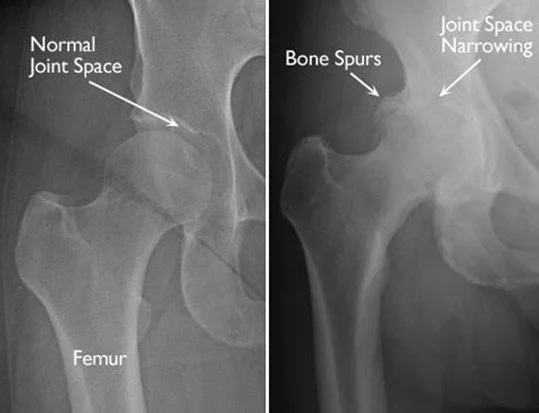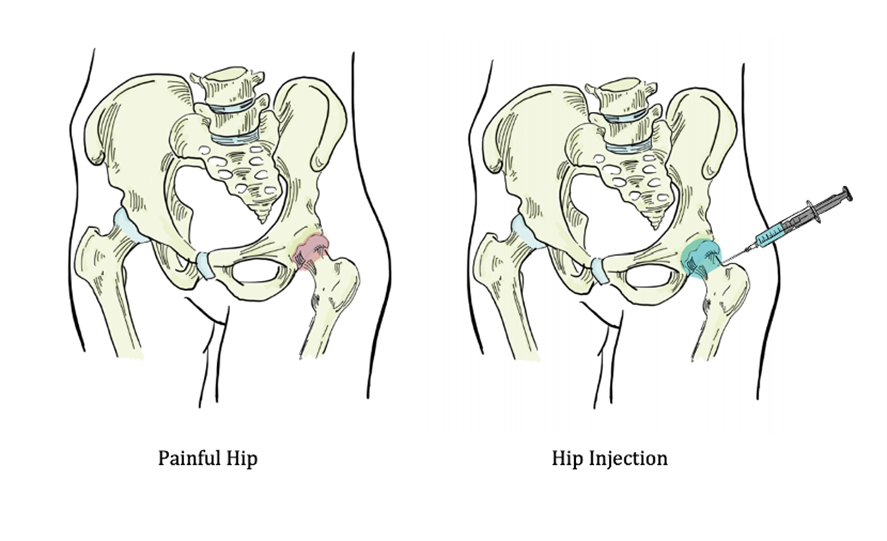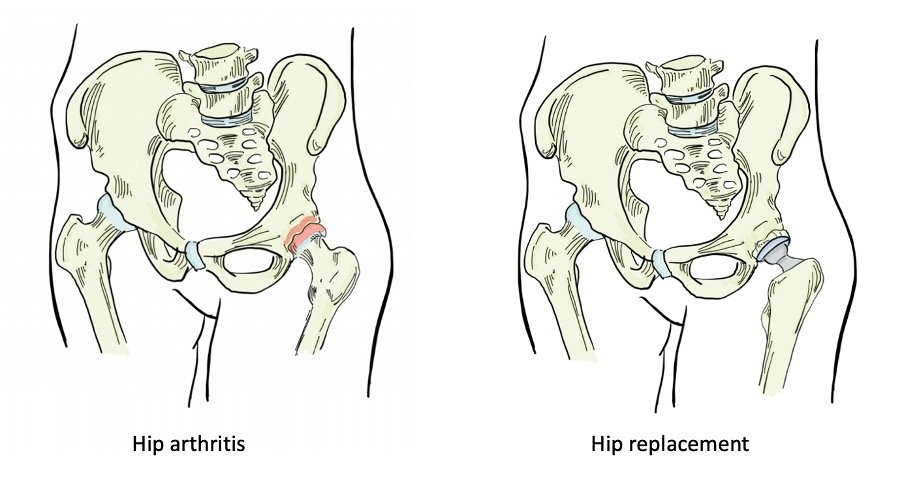Hip Arthritis
Home > Condition & Treatment Map > Hip & Pelvis Conditions & Treatments > Hip Arthritis
Overview
Sometimes called "wear-and-tear" arthritis, osteoarthritis is a common condition that many people develop during middle age or older. It can occur in any joint in the body, but most often develops in weight-bearing joints, such as the hip. Osteoarthritis of the hip causes pain and stiffness. It can make it hard to do everyday activities like bending over to tie a shoe, rising from a chair, or taking a short walk. Because osteoarthritis gradually worsens over time, the sooner you start treatment, the more likely it is that you can lessen its impact on your life. Although there is no cure for osteoarthritis, there are many treatment options to help you manage pain and stay active.
Anatomy
The hip is one of the body's largest joints. It is a "ball-and-socket" joint. The socket is formed by the acetabulum, which is part of the large pelvic bone. The ball is the femoral head, which is the upper end of the femur (thighbone).
The bone surfaces of the ball and socket are covered with articular cartilage, a smooth, slippery substance that protects and cushions the bones and enables them to move easily.
The surface of the joint is covered by a thin lining called the synovium. In a healthy hip, the synovium produces a small amount of fluid that lubricates the cartilage and aids in movement.
Description
Osteoarthritis is a degenerative type of arthritis that occurs most often in people 50 years of age and older, though it may occur in younger people, too.
In osteoarthritis, the cartilage in the hip joint gradually wears away over time. As the cartilage wears away it becomes rough, and the protective joint space between the bones decreases. This can result in bone rubbing on bone. To make up for the lost cartilage, the damaged bones may start to grow outward and form bone spurs (osteophytes).
Osteoarthritis develops slowly and the pain it causes worsens over time.
Causes
Osteoarthritis has many causes that may make you more likely to develop the disease, including:
Increasing age
Family history of osteoarthritis
Previous injury to the hip joint
Femoroacetabular impingement (FAI)
Improper formation of the hip joint at birth, a condition known as developmental dysplasia of the hip
Even if you do not have any of the risk factors listed above, you can still develop osteoarthritis.
Symptoms
The most common symptom of hip osteoarthritis is pain around the hip joint. Usually, the pain develops slowly and worsens over time, although sudden onset is also possible. Pain and stiffness may be worse in the morning, or after sitting or resting for a while. Over time, painful symptoms may occur more frequently, including during rest or at night. Additional symptoms may include:
Pain in your groin or thigh that radiates to your buttocks or your knee
Pain that flares up with vigorous activity
Stiffness in the hip joint that makes it difficult to walk or bend
"Locking" or "sticking" of the joint, and a grinding noise (crepitus) during movement caused by loose fragments of cartilage and other tissue interfering with the smooth motion of the hip
Decreased range of motion in the hip that affects the ability to walk and may cause a limp
Imaging Tests
X-rays
These imaging tests create detailed pictures of dense structures, like bones. X-rays of an arthritic hip may show a narrowing of the joint space, changes in the bone, and the formation of bone spurs (osteophytes).
(Left) In this x-ray of a normal hip, the space between the ball and socket indicates healthy cartilage. (Right) This x-ray of an arthritic hip shows severe loss of joint space and bone spurs.
Other imaging tests
Occasionally, a magnetic resonance imaging (MRI) scan, a computed tomography (CT) scan, or a bone scan may be needed to better determine the condition of the bone and soft tissues of your hip.
Treatment
Although there is no cure for osteoarthritis, there are several treatment options that will help relieve pain and improve mobility.
Nonsurgical Treatment
As with other arthritic conditions, early treatment of osteoarthritis of the hip is non-surgical.
Lifestyle modifications
Some changes in your daily life can protect your hip joint and slow the progress of osteoarthritis.
Minimizing activities that aggravate the condition, such as climbing stairs.
Switching from high-impact activities (like jogging or tennis) to lower impact activities (like swimming or cycling) will put less stress on your hip.
Losing weight can reduce stress on the hip joint, resulting in less pain and increased function.
Physiotherapy
Specific exercises can help increase range of motion and flexibility, as well as strengthen the muscles in your hip and leg. Your doctor or physical therapist can help develop an individualized exercise program that meets your needs and lifestyle.
Assistive devices
Using walking supports like a cane, crutches, or a walker can improve mobility and independence. Using assistive aids like a long-handled grasper to pick up low-lying things will help you avoid movements that may cause pain.
Medications
Panadol and anti-inflammatories are commonly used in conjunction with other treatments to control the pain and inflammation of arthritis. When these are failing to control your pain adequately, it may be an indication that surgery may be required.
Injections
Various injections can be performed to reduce the inflammation in the hip and these can be discussed with you during your consultation.
Surgical Treatment
Victorian Bone and Joint surgeons may recommend surgery if your pain from arthritis causes disability and is not relieved with nonsurgical treatment.
Total hip replacement
Both the damaged acetabulum(socket) and femoral head(ball) are removed, and then position new metal, plastic or ceramic joint surfaces to restore the function of your hip. Victorian Bone and Joint surgeons only uses implants with an excellent long-term record and survivorship.
Frequently Asked Questions
What is the difference between hip dysplasia and hip arthritis?
While symptoms may be similar, Hip dysplasia is a developmental disorder largely influenced by genetics. Hip arthritis on the other hand can be caused by a range of factors including weight, joint injury or increasing age.
What is the difference between hip arthritis and a labral tear?
Labral tears are typically caused by trauma, arthritis, femoroacetabular impingement or acetabular dysplasia, while the most common cause of hip arthritis is old age. Labral tears are also more common in athletes, however people with labral tears in their hip are also more likely to develop hip arthritis.





